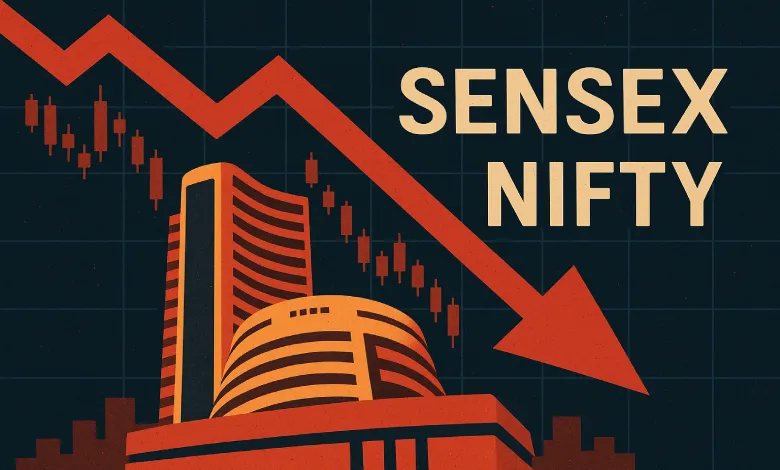
Indian equity markets ended their brief two-session rally on Tuesday, May 27, with major indices posting substantial declines as investor sentiment turned cautious.
The BSE Sensex began trading at 82,038.20, down from Monday’s closing level of 82,176.45, before plummeting to a session low of 81,121.70 – a decline of 1,055 points or 1.3 percent. Similarly, the Nifty 50 started at 24,956.65 compared to its previous finish of 25,001.15, touching an intraday bottom of 24,704.10 with a 1.2 percent drop.
By market close, both indices had recovered from their worst levels. The Sensex finished down 625 points or 0.76 percent at 81,551.63, while the Nifty 50 concluded 175 points or 0.70 percent lower at 24,826.20.
Contrary to the benchmark indices, mid-cap and small-cap stocks showed resilience. The BSE Midcap index gained 0.18 percent while the Smallcap index advanced 0.19 percent.
The total market value of companies listed on BSE declined to approximately ₹444 lakh crore from the previous session’s ₹445 lakh crore.
Five Factors Behind Today’s Market Decline
Global Market Weakness Triggers Selling
International market volatility influenced domestic trading sentiment. Asian markets, including Japan’s Nikkei and Korea’s Kospi, fell on worries that US President Donald Trump’s proposed tax reductions could increase America’s budget deficit. This global uncertainty led investors to secure gains, with 40 out of 50 Nifty companies closing in negative territory.
Reduced Foreign Investment Activity
Foreign portfolio investors (FPIs) have shown diminished interest in Indian markets during May, with sporadic selling due to limited positive catalysts. FPI purchases on May 26 totaled just ₹135.98 crore, indicating weakening foreign capital flows that are pressuring market performance.
High Market Valuations Concern Investors
The Nifty 50’s current price-to-earnings ratio of 22.6 exceeds its 12-month average of 22.15. Without significant earnings improvements, these elevated valuations make investors uncomfortable about current market levels.
VK Vijayakumar, Chief Investment Strategist at Geojit Investments, explained that near-term market consolidation is expected. He noted that while mutual funds hold substantial cash reserves ready to purchase on dips, expensive valuations will prompt selling during rallies. Sustained growth requires evidence of earnings recovery, which remains distant.
Geopolitical Tensions Create Uncertainty
International political risks continue making investors wary, prompting protective selling strategies to safeguard portfolios.
Krishnan V R, Chief of Quantitative Research at Marcellus, told Media that markets appear to anticipate earnings growth improvement in FY26/27 supported by better macroeconomic conditions. However, he cautioned that current valuations may not fully account for risks from complex tariff negotiations with the US and structural challenges like sluggish wage growth.
Absence of Near-Term Positive Catalysts
Despite favorable long-term fundamentals including solid macroeconomic indicators, predictions of above-average monsoon conditions, and strong retail investor participation, markets lack immediate positive developments to sustain momentum.
Market attention now shifts to the Q4 GDP data release on May 30 and the Reserve Bank of India’s monetary policy announcement scheduled for June 6.




